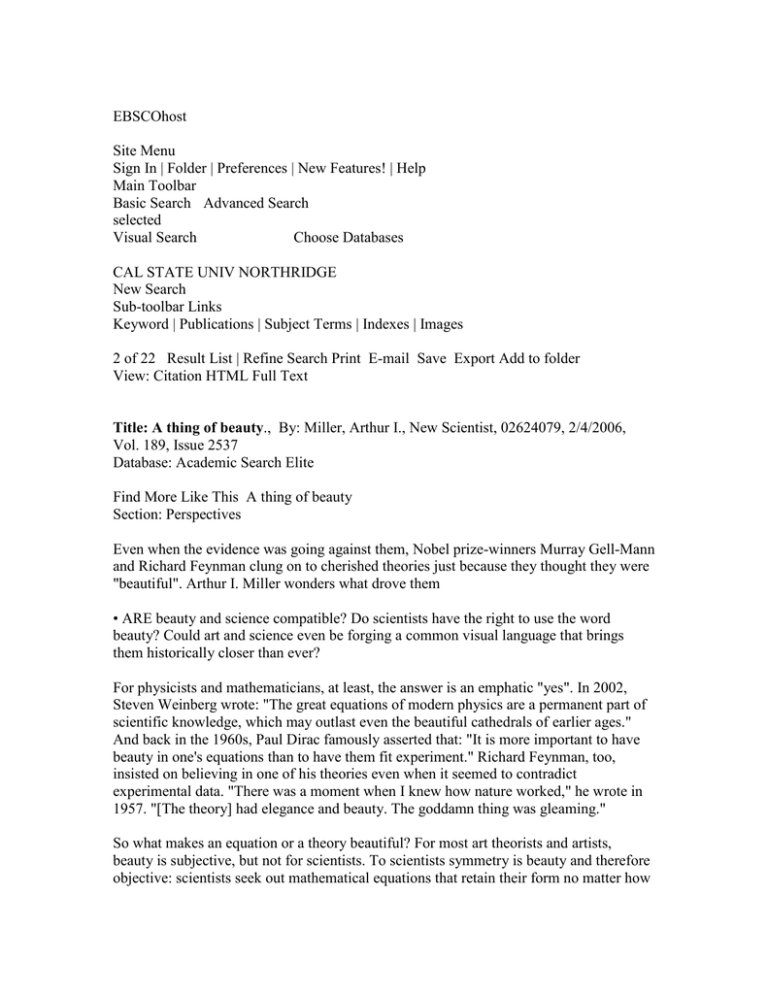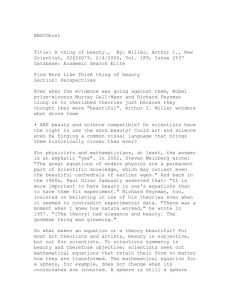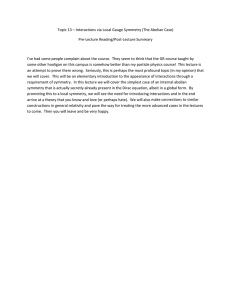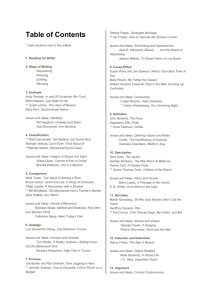
EBSCOhost
Site Menu
Sign In | Folder | Preferences | New Features! | Help
Main Toolbar
Basic Search Advanced Search
selected
Visual Search
Choose Databases
CAL STATE UNIV NORTHRIDGE
New Search
Sub-toolbar Links
Keyword | Publications | Subject Terms | Indexes | Images
2 of 22 Result List | Refine Search Print E-mail Save Export Add to folder
View: Citation HTML Full Text
Title: A thing of beauty., By: Miller, Arthur I., New Scientist, 02624079, 2/4/2006,
Vol. 189, Issue 2537
Database: Academic Search Elite
Find More Like This A thing of beauty
Section: Perspectives
Even when the evidence was going against them, Nobel prize-winners Murray Gell-Mann
and Richard Feynman clung on to cherished theories just because they thought they were
"beautiful". Arthur I. Miller wonders what drove them
• ARE beauty and science compatible? Do scientists have the right to use the word
beauty? Could art and science even be forging a common visual language that brings
them historically closer than ever?
For physicists and mathematicians, at least, the answer is an emphatic "yes". In 2002,
Steven Weinberg wrote: "The great equations of modern physics are a permanent part of
scientific knowledge, which may outlast even the beautiful cathedrals of earlier ages."
And back in the 1960s, Paul Dirac famously asserted that: "It is more important to have
beauty in one's equations than to have them fit experiment." Richard Feynman, too,
insisted on believing in one of his theories even when it seemed to contradict
experimental data. "There was a moment when I knew how nature worked," he wrote in
1957. "[The theory] had elegance and beauty. The goddamn thing was gleaming."
So what makes an equation or a theory beautiful? For most art theorists and artists,
beauty is subjective, but not for scientists. To scientists symmetry is beauty and therefore
objective: scientists seek out mathematical equations that retain their form no matter how
they are transformed. The mathematical equation for a sphere, for example, does not
change when its coordinates are inverted. A sphere is still a sphere when viewed from
any perspective, even in a mirror. This is the mathematical reason why the sphere is often
considered the most perfect of forms.
And if experiments on the decay process of elementary particles produce the same results
when viewed in a mirror, they exhibit "mirror symmetry", associated with the law of the
conservation of parity. Call it what you will, there is a basic element in most scientific
theories that scientists believe they can quantify objectively as "aesthetics" or "beauty".
Why is symmetry so important? Why is it the term that scientists use synonymously with
beauty? For many, it goes back to that fraction of a second after the big bang, some 13.7
billion years ago, when there was only one force — an instant of purest symmetry. When
this symmetry was broken, the four forces of the physical world emerged: the
gravitational, electromagnetic, nuclear and weak forces. The universe is now seen as
being made up of broken symmetries. What scientists are trying to do is to find this
primordial symmetry by hypothesising other symmetries that unify these four forces.
When scientists look for explanations for what "breaks" these symmetries, they discover
particles. Theories which exhibit the maximum symmetry — such as those unifying
fundamental forces, like the electroweak theory — are considered "beautiful theories",
and they usually turn out to be correct, which seems to justify the hunt for symmetry.
Symmetry need not be tied to visual imagery — the need could reflect an intuition about
how nature ought to be. This was Einstein's starting point in 1905 when he introduced
aesthetics into 20th-century physics. In his first paper that year, he argued that the
"profound formal distinction" scientists made that particles of electrons emit waves of
light was unwarranted. Why not just hypothesise particles of electrons emitting particles
of light? Thus, his discovery that light could also be a particle emerged from his
minimalist aesthetic.
His formulation of the theory of relativity also sprang from this aesthetic. The
electromagnetic theory of the day offered two radically different explanations of how a
current is generated in a wire moving relative to a magnet, depending on whether the
current was observed by someone riding on the wire or on the magnet. To Einstein the
two explanations were redundant: worse, they were asymmetrical. Surely the only real
difference was viewpoint? Having unmasked this asymmetry, he could extend the
principle of relativity to electricity, magnetism and light.
Two years later, Einstein applied the aesthetic of minimalism yet again. Day-dreaming in
his job at the Patent Office in Bern, Switzerland, he considered the case of a falling stone,
drawn towards the ground by gravity. The physicists of the day distinguished between the
"inertial mass" of the stone, as it appeared in Newton's law, which related the force acting
on an object to its mass times its acceleration, and the stone's "gravitational mass", which
is its mass as described in Newton's law of gravity. Precision measurements indicated
they were probably the same. Why have two masses when one sufficed? It was another
asymmetry.
Ignoring experimental accuracy, Einstein took them to be exactly equal, a breathtaking
leap which led him to realise that acceleration and gravity were relative to each other.
This was to be the basis for his general theory of relativity — a theory scientists often
describe as the most beautiful theory ever proposed.
For me its beauty goes beyond the minimalist, or conceptual, beauty of Einstein's earlier
discoveries. It lies in its mathematical representation — and I use the term
"representation" because mathematics is the means by which scientists represent nature,
in the same way artists use paint and canvas.
Einstein was struggling to find a mathematical version of Newton's gravitational theory
which would keep its form when moved from one point to another in four-dimensional
space-time. If the equations Einstein sought could satisfy this, then the laws of nature for
every observer would be the same. This is the principle of relativity. Each observer (the
different observers on a magnet and a wire, or the different observers viewing a Cubist
painting) sees a different aspect of the same phenomenon. Einstein had achieved this
symmetry with his special relativity theory; his aim was then to find a generalisation of it
to include gravity.
He accomplished this by expressing his new theory in terms of tensors — complex
mathematics that described a flexible geometry of space-time whose shape was
determined by the bodies in it. Gravity turned out to be a deformation of space caused by
these bodies. As an incidental benefit, this mathematics revealed some surprising features
of nature, such as that starlight could be bent by massive objects — verified in 1919. It
also predicted that a dying star might begin an eternal collapse and fall into a well in
space from which nothing could escape, not even light — what we now know as a black
hole.
Here, however, Einstein's aesthetic sense failed him: he dismissed black holes as an ugly
solution to a beautiful theory. After all, how could something as big as a star possibly
collapse to a point of infinite density? Most other physicists agreed. Tellingly, when
black holes finally entered the scientific mainstream in the 1960s, the mathematical
theory behind them was re-worked in new ways to reveal their essential beauty. They
have since actually been observed.
Dirac's statement at the start of this essay on the importance of "beauty in one's
equations" was intended for Erwin Schrödinger. In Schrödinger's first attempt to concoct
his famous wave equation, he looked for one that agreed with relativity theory. The
equation he came up with, however, was not supported by experiment. Eventually he
produced the Schrödinger equation, which was not beautiful, but did at least fit the data.
Dirac thought that Schrödinger should have ignored the data and persevered in his pursuit
of a beautiful equation.
Dirac did just that. He discovered an equation that was consistent with relativity theory
but represented in a mathematics unfamiliar to most physicists — spinors, intermediate
between vectors and tensors. The problem was that it predicted particles with negative
energy, which everyone thought an impossibility. Werner Heisenberg condemned it as
the "saddest chapter in theoretical physics". Shortly afterwards, Dirac realised that these
particles were actually antiparticles with positive energy. They were later discovered in
the laboratory. Once again insisting on beauty in a mathematical theory revealed
unexpected features of nature.
Dirac's equation dates back to 1928. By then the "battle between the waves and the
particles", as Heisenberg called it, was over. It had been fought purely over aesthetics: the
aesthetics of waves versus the aesthetics of particles, and the choice of mathematical
formalism to describe it. What was at stake was the representation of physical reality.
Schrödinger wrote that he was "repelled" by Heisenberg's quantum mechanics because it
was formulated in an ugly mathematics. Schrödinger preferred his own wave mechanics
with its classical imagery of electrons as waves.
Heisenberg replied that Schrödinger's "pictures" were "crap". Niels Bohr came to the
rescue with his insistence on an aesthetic that included both waves and particles, thus
satisfying most of the physicists involved. But the problem of finding the right, beautiful,
visual imagery persisted when it came to the world of the atom. It was solved by
Feynman in 1948. The Feynman diagrams, generated by the mathematics of quantum
mechanics, provide a glimpse into the atomic world.
Now, the advent of quantum mechanics led physics full circle back to Plato who, some
3000 years earlier, had regarded mathematics as the only way to glimpse the reality
beyond appearances. The beauty of the mathematics of quantum theory turns out to be
fine-tuned, linking each symmetry in nature to a law of conservation, such as the
conservation of energy and of momentum. These laws help us fashion the mathematics of
a theory correctly. Whenever physicists have proposed theories that violated them, they
have failed.
Sometimes, however, a law of conservation is violated. The law of the conservation of
parity, for example, states that a theory's mathematical structure should show a symmetry
between left and right — the symmetry of the sphere. As the ancient Greeks knew,
beauty can be enhanced by a small degree of asymmetry. Nature agrees. When an
elementary particle decays because of the "weak interaction", it produces an electron and
a neutrino, and it violates parity. Asymmetry is what the data shows so it has to enter the
equation. But how to do it without creating ugliness?
In 1957, experimental evidence weighed heavily against Murray Gell-Mann and Richard
Feynman's theory of weak interactions. As we saw, Feynman had declared that the theory
"had elegance and beauty. The goddamn thing was gleaming". In other words, it had an
inner perfection that suggested it could be generalised further, it hinted at how to unify
the weak and electromagnetic interactions, and its mathematical representation was the
simplest that could be constructed.
Despite the high reputation of the physicists responsible for the actual experiments,
Feynman and Gell-Mann's response was that there was something wrong with the
experiments. They were right. Thus although experiments are essential for scientific
theories, certain theories are just too important — too beautiful, one could say — to be
discarded when the experiments don't go your way. Perhaps in the future beauty will
provide an important criterion for selecting one theory over another, now that theories are
emerging which cannot be verified by experimentation as we know it today.
Both art and science shift between symmetry and asymmetry. The skewed faces in
Picasso's Les Demoiselles d'Avignon and the pleasing asymmetries in his Les Trois
Musiciens break what cognitive scientists call laws of good form. These are the laws that
enable us to organise perceptions into patterns that are reasonably understandable, to
create order out of a chaos of sense perceptions.
Progressively throughout the 20th century, mathematics began to impinge on art. Most
recently, scientists found that Jackson Pollock's repetitive yet complex drip paintings
bore a striking similarity to chaotic systems. Without realising it, Pollock found a way to
represent nature using fractal patterns, reflecting the very fingerprint of nature.
The past is peppered with true artist-scientists such as Albrecht Dürer and Leonardo da
Vinci, whose studies of projective geometry and perspective led to the concept of infinity
in western science. Today, art and science appear to be moving closer together again.
Artists use scientific equipment and concepts, scientists employ aesthetics. Both deal
with visual imagery and metaphor. And both have followed parallel paths of increasing
abstraction as they have progressed.
Some hundred years from now, art and science may well share a common language. As
technology advances, could a new visual language emerge to blur or even obliterate the
distinction between art and science?
"Einstein dismissed black holes as an ugly solution to a beautiful theory. Most physicists
agreed"
PHOTO (COLOR): In Les Trois Musiciens, Picasso plays with "good form", the laws
that enable us to make sense out of chaos
PHOTO (COLOR): Jackson Pollock's drip paintings unintentionally captured fractal
patterns, the deep signature of nature
PHOTO (COLOR): Could science and art ever move as close as they were in the late
medieval world of Leonardo da Vinci?
~~~~~~~~
By Arthur I. Miller
Arthur I. Miller trained as a physicist, is now a science historian, and writes on art
history. He is based at University College London. His most recent book is Empire of the
Stars: Friendship, obsession and betrayal in the quest for black holes , Little Brown, April
2005, £17.99
© 2006, New Scientist, Reed Business Information UK, Ltd., a division of Reed Elsevier,
Inc. All Rights Reserved. Copyright of New Scientist is the property of Reed Business
Information and its content may not be copied or emailed to multiple sites or posted to a
listserv without the copyright holder's express written permission. However, users may
print, download, or email articles for individual use.
View: Citation HTML Full Text
2 of 22 Result List | Refine Search Print E-mail Save Export Add to folder
Top of Page
EBSCO Support Site
* Privacy Policy
* Terms of Use
* Copyright
© 2007 EBSCO Industries, Inc. All rights reserved.






